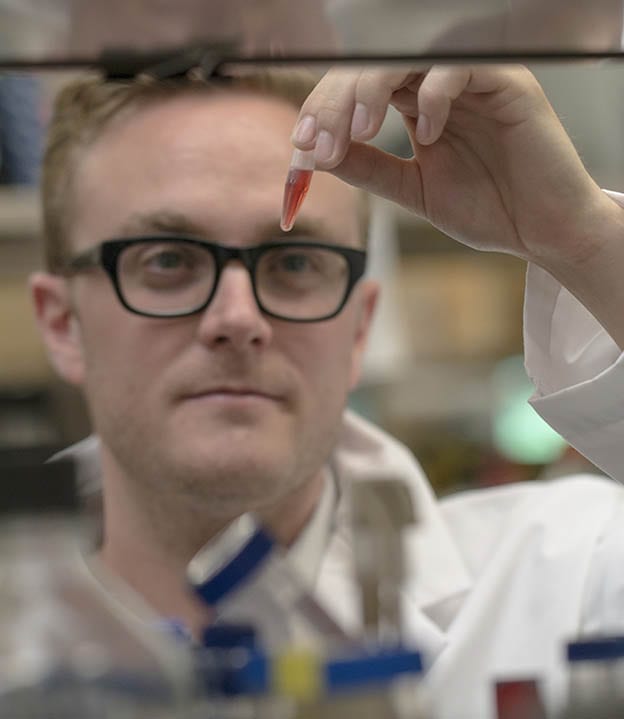
Goal is to Distinguish Between Viral and Bacterial Infections, Reduce Unnecessary Use of Antibiotics
Antibiotics are lifesaving drugs, but overuse is leading to one of the world’s most pressing health threats: antibiotic resistance. Researchers at the University of Rochester Medical Center are developing a tool to help physicians prescribe antibiotics to patients who really need them, and avoid giving them to individuals who don’t.
Scientists from the University’s National Institutes of Health-funded Respiratory Pathogens Research Center identified 11 genetic markers in blood that accurately distinguished between viral and bacterial infections (antibiotics help us fight bacterial infections, but aren’t effective and shouldn’t be used to treat viruses). The finding, published in the journal Scientific Reports, is important because physicians don’t have a good way to confirm bacterial infections like pneumonia and more-often-than-not default to an antibiotic.
“It’s extremely difficult to interpret what’s causing a respiratory tract infection, especially in very ill patients who come to the hospital with a high fever, cough, shortness of breath and other concerning symptoms,” said Ann R. Falsey, M.D., lead study author, professor and interim chief of the Infectious Diseases Division at UR Medicine’s Strong Memorial Hospital. “My goal is to develop a tool that physicians can use to rule out a bacterial infection with enough certainty that they are comfortable, and their patients are comfortable, foregoing an antibiotic.”
Falsey’s project caught the attention of the federal government; she’s one of 10 semifinalists in the Antimicrobial Resistance Diagnostic Challenge, a competition sponsored by NIH and the Biomedical Advanced Research and Development Authority to help combat the development and spread of drug resistant bacteria. Selected from among 74 submissions, Falsey received $50,000 to continue her research and develop a prototype diagnostic test, such as a blood test, using the genetic markers her team identified.
A group of 94 adults hospitalized with lower respiratory tract infections were recruited to participate in Falsey’s study. The team gathered clinical data, took blood from each patient, and conducted a battery of microbiologic tests to determine which individuals had a bacterial infection (41 patients) and which had a non-bacterial or viral infection (53 patients). Thomas J. Mariani, Ph.D., professor of Pediatrics and Biomedical Genetics at URMC, used complex genetic and statistical analysis to pinpoint markers in the blood that correctly classified the patients with bacterial infections 80 to 90 percent of the time.
“Our genes react differently to a virus than they do to bacteria,” said Mariani, a member of the Respiratory Pathogens Research Center (RPRC). “Rather than trying to detect the specific organism that’s making an individual sick, we’re using genetic data to help us determine what’s affecting the patient and when an antibiotic is appropriate or not.”
Falsey, co-director of the RPRC, and Mariani say that the main limitation of their study is the small sample size and that the genetic classifiers selected from the study population may not prove to be universal to all patients
Learn more: URMC Researchers Developing New Tool to Fight Antibiotic Resistance
The Latest on: Antibiotic resistance
[google_news title=”” keyword=”antibiotic resistance” num_posts=”10″ blurb_length=”0″ show_thumb=”left”]- A vaccine to combat antibiotic resistanceon April 27, 2024 at 2:00 pm
A team of researchers at Michigan State University have outlined an approach to combating a prevalent public health issue: the development of treatment-res | Technology ...
- Cats And Dogs Can Spread Antibiotic Resistant Superbugs To Ownerson April 27, 2024 at 10:55 am
Transfer of bacteria between sick pets and their humans may be contributing to antibiotic resistance, according to new research.
- Experts develop way to harness CRISPR technology to deal with antimicrobial resistanceon April 26, 2024 at 3:10 pm
Antimicrobial resistance (AMR) is continuing to increase globally, with rates of AMR in most pathogens increasing and threatening a future in which every day medical procedures may no longer be ...
- Common antibiotic Neosporin may shield against viral respiratory infectionson April 26, 2024 at 9:00 am
A study conducted first in mice and then in human volunteers suggests that a common antibiotic, neomycin, which is the main active ingredient in Neosporin, may help protect against viral respiratory ...
- What to Know About Pivya, the New Antibiotic Treatment for UTIson April 26, 2024 at 4:06 am
The Food and Drug Administration recently approved Pivya (pivmecillinam) to treat uncomplicated UTIs in female adults. Clinical trials show that Pivya is effective and side effects are limited.
- Superbugs could lower your life expectancy by nearly 2 years, report says. What to know about antimicrobial resistanceon April 25, 2024 at 5:25 pm
Public Health Emergency, a group of international political, public health, and biomedical leaders warns of another menace to human life that could also trigger economic loss. Antimicrobial ...
- A Vaccine to Fight Antibiotic Resistanceon April 25, 2024 at 2:25 pm
MSU, Harvard Medical School team up to expand vaccine science’s role in the fight against MRSA and other infections ...
- Climate change fuels the rise of global antimicrobial resistanceon April 25, 2024 at 10:34 am
Climate change exacerbates antimicrobial resistance by altering environments where microbes thrive, leading to increased disease spread.
- Researchers develop vaccine to fight antibiotic resistanceon April 24, 2024 at 11:37 pm
Driven by the overuse of antimicrobials, pathogens are quickly building up resistances to once-successful treatments. It’s estimated that antimicrobial-resistant infections killed more than 1 million ...
- Antibiotic resistance in babies varies according to mode of birth, prematurity and where they live, says analysison April 24, 2024 at 3:10 pm
A meta-analysis of genetic studies analyzing the microbiota (bacteria in the gut) of 1,275 infants from 10 countries finds that cesarean delivery and antibiotic use are driving the increase of ...
via Google News and Bing News










